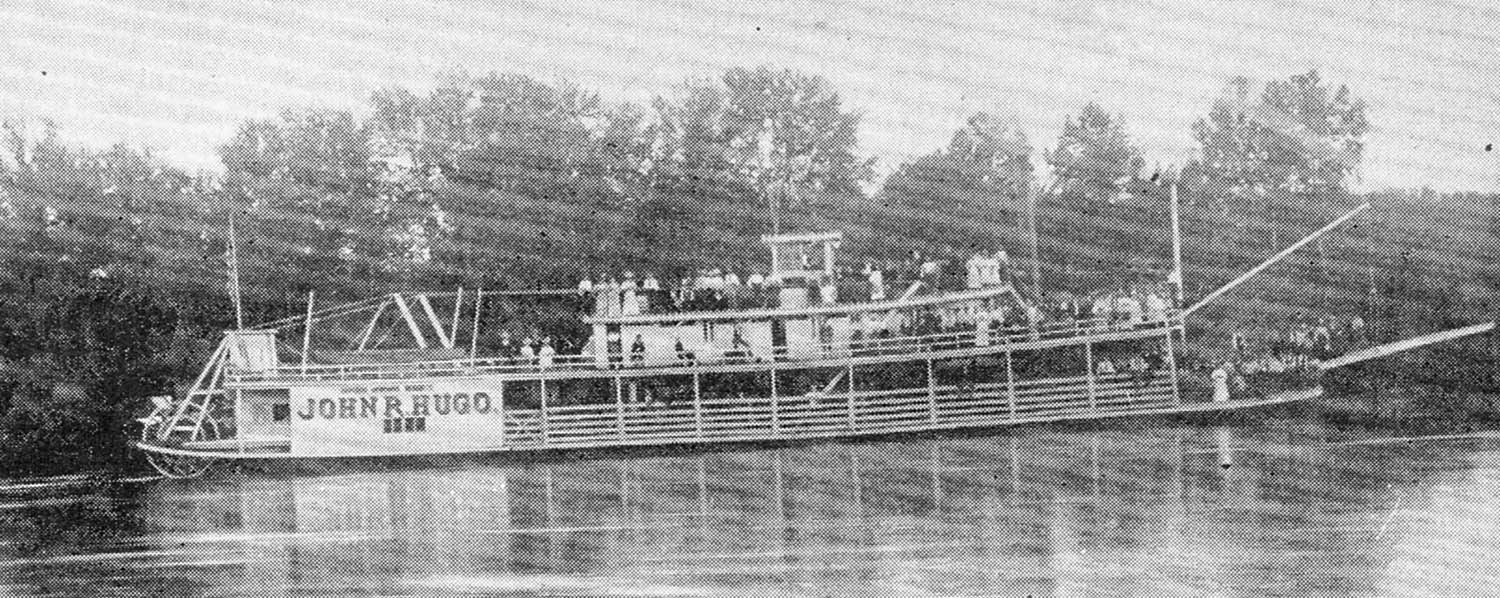Built at Evansville, Ind., in 1879, the John R. Hugo was originally listed as a towboat. The wood hull was only 82.6 feet in length by 20 feet in width. Records list the boat as having inspections at Evansville in December 1884, February 1885, February 1886 and January 1887.
The 1888 inspection was done at Mt. Vernon, Ind., at which time the vessel was reclassified as a packet.
The Hugo had engines containing 12.5-inch cylinders with a 3.5-foot stroke. One boiler supplied the steam. On March 9, 1887, while unloading freight at Mt. Vernon, two deckhands reportedly had an altercation with one of them being knocked overboard; the man was rescued.
In the spring of 1889, the Hugo underwent inspection at Jefferson City, Mo. The boat had been purchased by Capt. Robert M. Marshall and taken to the Missouri River to augment his steamer Frederick in delivering Osage River wheat to the Missouri Pacific Railroad at Osage City, Mo.
In late 1888, Marshall, in partnership with Capt. Henry Castrup, rebuilt the sternwheeler into a larger vessel. The hull was now 127 feet in length, retaining the 20 foot beam.
On May 7, 1896, the Hugo was at St. Louis, indicating that Capt. Marshall sometimes delivered the wheat and other freight to St. Louis without transferring to the railroad. Occasionally, Marshall ventured well upstream on the Missouri, inasmuch as the Hugo was at Nebraska City for its annual inspection on June 11, 1898. Business apparently was lucrative above Kansas City in 1898 for the riverboat, as the annual inspection was listed as taking place at Omaha. A subsequent inspection is listed as occurring at Leavenworth, Kan., on May 9, 1900.
On May 22 of that year, while at Florence, Neb., the Hugo caught fire, allegedly from the explosion of a lamp in the engineroom; the blaze destroyed the second deck cabin and upper works. The hull was floated down to Osage City using steering oars by brothers Capt. William Thompson and Capt. Hal Thompson.
The machinery from the Hugo was placed aboard a new steamboat, the Osage. This vessel was both packet and towboat, built on a wooden hull measuring 100 feet in length by 19.8 feet in width. After a brief career on the Missouri and Osage rivers, this sternwheeler was sold to the Houston Lumber Company at Vicksburg, Miss. In 1909, the boat was purchased by the Mississippi, Yazoo & Sunflower River Transportation Company, which installed a new hull. The Osage was dismantled in 1917.
Following the fire that all but destroyed the John R. Hugo, Capt. Bob Marshall retired from the river and took his wife on a trip to Europe. In 1902, Marshall organized a bank at Tuscumbia, Mo., his home town, and was bank president for some years. In the autumn of 1901, the War Department approved Marshall’s plans for a wire suspension bridge over the Osage near Tuscumbia. The former riverman had made sure that the channel span had adequate clearance above high water and was 604 feet in width.
Editor’s note: For questions or suggestions regarding the Old Boat Column, Keith Norrington may be contacted by e-mail at curatorkeith@yahoo.com, or by mail through the Howard Steamboat Museum at P.O. Box 606, Jeffersonville, Ind. 47131-0606.
Caption for photo: The towboat/packet John R. Hugo at a landing. (Keith Norrington collection)




